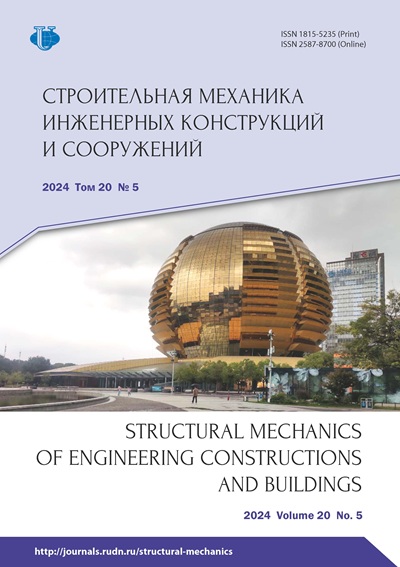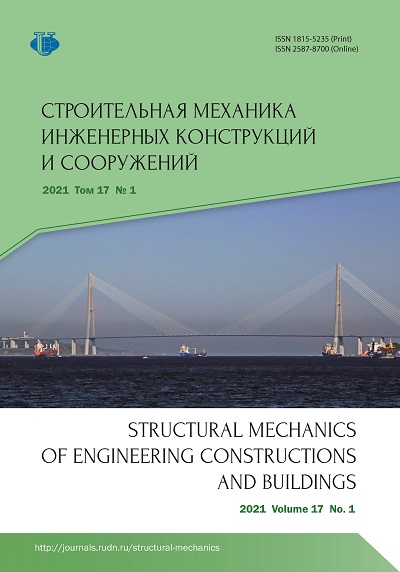Распространенные дефекты и их влияние на характеристики железобетонного здания
- Авторы: Гимире К.1, Чаулагейн Х.1
-
Учреждения:
- Университет Покхары
- Выпуск: Том 17, № 1 (2021)
- Страницы: 63-73
- Раздел: Аналитические и численные методы расчета конструкций
- URL: https://journals.rudn.ru/structural-mechanics/article/view/26187
- DOI: https://doi.org/10.22363/1815-5235-2021-17-1-63-73
Цитировать
Полный текст
Аннотация
Во многих странах погрешности в проектировании зданий часто сказываются не только на их эстетическом виде, но и на техническом состоянии. Череда землетрясений, произошедших как в Непале, так и во всем мире, продемонстрировала высокий уровень сейсмической уязвимости зданий из-за погрешностей их проектирования и возведения. Принимая во внимание этот факт, в настоящем исследовании освещаются общие дефекты и их влияние на характеристики железобетонных зданий. Влияние конструктивных погрешностей изучено с помощью численного анализа. Геометрические погрешности и погрешности в характеристиках материала конструкций и жесткостей их сечений моделировались путем удаления пролетов в различных уровнях пола и удаления колонн в различных местах соответственно. В процессе численного исследования были созданы конечно-элементные модели в системе SAP2000. Характеристики конструкции изучались с использованием нелинейного статического прогона и динамического расчета изменений во времени. Результаты показали, что количество дефектов существенно влияет на поведение конструкций.
Ключевые слова
Об авторах
Кришна Гимире
Университет Покхары
Автор, ответственный за переписку.
Email: hchaulagain@gmail.com
студент Инженерной школы, магистр в области строительного проектирования
Федеративная Демократическая Республика Непал, Каски, Лекхнат, Pokhara Metropolitan City-30Хемчандра Чаулагейн
Университет Покхары
Email: hchaulagain@gmail.com
доцент Инженерной школы
Федеративная Демократическая Республика Непал, Каски, Лекхнат, Pokhara Metropolitan City-30Список литературы
- Kamal S., Jose D.CJ. Study of vertical irregularity in multi-storey building frames under seismic forces. International Journal of Current Engineering and Science Research. 2016;3(12):35-41.
- Naveen E.S., Abraham N.M., Kumari S.D.A. Analysis of irregular structures under earthquake loads. Procedia Structural Integrity. 2019;14:806-819.
- Kostinakis K., Athanatopoulou A. Effect of in-plan irregularities caused by masonry infills on the seismic behavior of RC buildings. Soil Dynamics and Earthquake Engineering. 2020;129:105598. https://doi.org/10.1016/j.soildyn.2019.03.012
- Varadharajan S., Sehgal V.K., Saini B. Review of different structural irregularities in buildings. Journal of Structural Engineering. 2012;39(5):538-563.
- Raheem S.E.A., Ahmed M.M.M., Ahmed M.M., Abdel-shafy A.G.A. Evaluation of plan configuration irregularity effects on seismic response demands of L-shaped MRF buildings. Bulletin of Earthquake Engineering. 2018; 16: 3845-3869. https://doi.org/10.1007/s10518-018-0319-7
- Khan P.I., Dhamge N.R. Seismic analysis of multistoried RCC building due to mass irregularity. International Journal of Engineering Development and Research. 2016;4(3):214-221.
- Nagod S., Zende A.J. Seismic analysis of multi-storeyed RC building due to mass irregularity by time history analysis. International Research Journal of Engineering and Technology (IRJET). 2017;4(8).
- Chaulagain H. Common structural deficiencies of RC buildings in Nepal. BSMC Journal of Local Development. 2016;1(1):130-141.
- Darashan D., Shruthi H.K. Study on mass irregularity of high-rise buildings. International Research Journal of Engineering and Technology. 2016;3(8):1123-1130.
- Dya A.F.C., Oretaa A.W.C. Seismic vulnerability assessment of soft story irregular buildings using pushover analysis. Procedia Engineering. 2015;125:925-932. https://doi.org/10.1016/j.proeng.2015.11.103
- Rahman S., Salik A. Seismic analysis of vertically irregular buildings. Current Science. 2016;111(10):1658-1663
- Amiri M., Yakhchalian M. Performance of Intensity Measures for Seismic Collapse Assessment of Structures with Vertical Mass Irregularity. Structures. 2020;24:728-741. https://doi.org/10.1016/j.istruc.2020.01.038
- Suravase MS., Pawar PM. Effect of geometrical plan irregularities on RCC multi-storey framed structure. International Journal of Engineering Trends and Technology (IJETT). 2017;47(5):314-317.
- Chaulagain H., Rodrigues H., Spacone E., Guragain R., Mallik R.K., Varum H. Response reduction factor of irregular RC buildings in Kathmandu Valley. Earthquake Engineering and Engineering Vibration. 2014;13(3):455-470. https://doi.org/10.1007/s11803-014-0255-8
- FEMA 356. Prestandard and Commentary for the Seismic Rehabilitation of Building. Washington, DC: Federal Emergency Management Agency; 1997.
- ATC 40. Seismic Evaluation and Retrofit of Concrete Building. Redwood City, California: Applied Technical Council, California Seismic Safety Commission; 1996.
- Nahavandi H. Pushover Analysis of Retrofitted Reinforced Concrete Building. M.Sc. Project Reports. Portland State University; 2015.
- SAP 2000 V-20. Integrated Finite Element Analysis and Design of Structure Basic Analysis. Reference Manual. Berkeley, CA: Computers and Structure Inc.; 2009.
- Salihovic A., Ademovic N. Nonlinear analysis of reinforced concrete frame under lateral load. Coupled System Mechanics. 2017;6(4):523-537. https://doi.org/10.12989/csm.2017.6.4.523
- King M.E., Layne P.A. Dynamics of nonlinear cyclic systems with structural irregularity. Nonlinear Dynamics. 1998;15:225-244. https://doi.org/10.1023/A:1008291628528
- Cai J., Pan D. New structural irregularity assessing index for seismic torsional vibration. Advances in Structural Engineering. 2007;10(1):73-82. https://doi.org/10.1260/136943307780150887
















